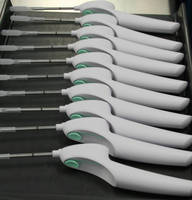Crescent Industries Helps Customers Understand the Causes of Shrink and Warp in Plastic Injection Molding

In order to understand the causes of shrink and warp in custom plastic injection molding, it is essential to comprehend what shrinkage is. Shrinkage is a reduction in size of the molded part as it cools. All injection molded parts shrink, but they do this by different degrees.
The amount of shrinkage needs to be accurately predicted. This can best be determined by part size and resin selection.
The reality is that different plastics shrink more than others. Some plastics shrink differently in one direction than in the other.
For example;
• Polymers filled with long glass fibers will shrink more in the cross direction than the longitudinal direction. The material supplier will tell you that you have to use a different shrink in the X axis than in the Y. If close tolerances matter - do not use asymmetrical shrinkage resins.
• Crystalline and semi-crystalline materials are particularly prone to thermal shrinkage. Amorphous materials tend to shrink less.Â
• Resins that are filled vs unfilled – filled resins generally shrink less than unfilled resins (resins can be filled with various materials, such as glass fiber, wood and mica to change the part’s properties).
The shrink of the resin must be taken into account when designing the mold. The cavity that forms the part is designed slightly over-sized to allow for shrinkage.
Understanding the Causes of Shrink and Warp in Custom Plastic Injection Molding
Your injection molder can fine-tune the shrinkage of the parts by adjusting the density of the material, i.e.; how they have packed it out and how long they hold it to cool in the tool.
Shrinkage can be caused by the following factors:
• The relationship of shrinkage to several processing parameters and part thickness, which is schematically plotted
• Low injection pressure, short pack-hold time or cooling time, high melt temperature, high mold temperature, low holding pressure
Achieving low and uniform shrinkage is a complicated task due to the presence and interaction of many factors such as molecular and fiber orientations, temperature variations within the molded part and by variable packing – such as over packing at the gates and under packing at remote locations or different pressure levels as material solidifies across the part’s thickness part.
During injection molding, the variation in shrinkage both globally and through the cross section of a part creates internal stresses or residual stresses. This acts on a part with effects similar to externally applied stresses. If the residual stresses induced during molding are high enough to overcome the structural integrity of the part, the part will warp upon ejection.
Warping is a distortion in the intended shape of the molded part that occurs during cooling. Warping can make the parts twist, fold, bend and bow. Mold design should consider the potential for part warping which can be caused by non-uniform mold cooling.
Variations in part thickness – the differences in shrink rates between thick and thin areas can also cause the part to warp, as can improperly gated parts.
Reducing and Controlling Shrinkage and Warping
To reduce or control shrinkage and warping it is also essential to avoid non-uniform wall thickness. You need to balance the filling pattern, and use a proper packing pressure level. This allows sufficient packing time and removes the pressure after the gate freeze. The cooling system should apply uniform cooling across both the thickness and throughout the part, in order to reduce residual stress.
For expert advice on custom plastic injection molding contact the professionals at Crescent Industries today by phone 717-759-0126 or visit our website www.crescentind.com.




